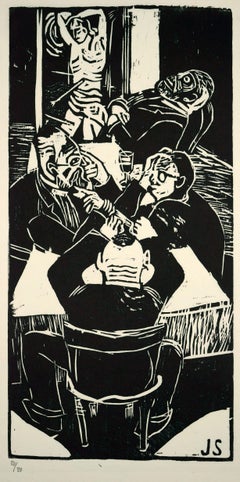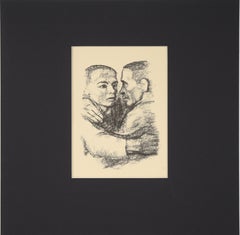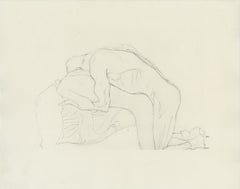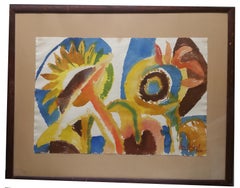Josef Scharl Art
to
1
Overall Width
to
Overall Height
to
1
1
1
1
1
1
1
1
1
1
1
1
10,025
2,754
1,379
1,375
1
Artist: Josef Scharl
Mockery / - Desk Perpetrators -
By Josef Scharl
Located in Berlin, DE
Josef Scharl (1896 Munich - 1954 New York), Mockery, 1935 (1964), Bronner 30 A. Woodcut on Japanese paper, 51.8 x 25.7 cm (image), 65 cm x 37 cm (sheet size), signed lower right in t...
Category
1930s Expressionist Josef Scharl Art
Materials
Paper
Related Items
"Brotherhood" lithograph by Käthe Kollwitz
By Käthe Kollwitz
Located in Soquel, CA
Bold print of "Brotherhood" by Kathe Kollwitz (German, 1867-1945). This piece is one of the Lithographic reproductions of the original lithographs, plate 3 from a series of 10, print...
Category
1940s Expressionist Josef Scharl Art
Materials
Paper, Ink, Lithograph
"Couple Making Love" by Gustav Klimt - Original Print from Courtesans Folio
By Gustav Klimt
Located in Palm Beach, FL
Plate #4 from Gustav Klimt's 1907 "Dialogues of the Courtesans" portfolio, consisting of 15 collotypes on cream japon paper. The drawings in this folio are said to be studies for Kli...
Category
Early 1900s Vienna Secession Josef Scharl Art
Materials
Paper
$2,400
H 11 in W 13.75 in
"Woman Leaning Forward" by Gustav Klimt - Original Print from Courtesans Folio
By Gustav Klimt
Located in Palm Beach, FL
Plate #3 from Gustav Klimt's 1907 "Dialogues of the Courtesans" portfolio, consisting of 15 collotypes on cream japon paper. The drawings in this folio are said to be studies for Klimt's well-known Water Serpents paintings...
Category
Early 1900s Vienna Secession Josef Scharl Art
Materials
Paper
$2,400
H 13.75 in W 11 in
"Masturbating Woman" by Gustav Klimt - Original Print from Courtesans Folio
By Gustav Klimt
Located in Palm Beach, FL
Plate #9 from Gustav Klimt's 1907 "Dialogues of the Courtesans" portfolio, consisting of 15 collotypes on cream japon paper. The drawings in this folio are said to be studies for Klimt's well-known Water Serpents paintings...
Category
Early 1900s Vienna Secession Josef Scharl Art
Materials
Paper
$3,400
H 11 in W 13.75 in
"Sleeping Woman" by Gustav Klimt - Original Print from Courtesans Folio
By Gustav Klimt
Located in Palm Beach, FL
Plate #1 from Gustav Klimt's 1907 "Dialogues of the Courtesans" portfolio, consisting of 15 collotypes on cream japon paper. The drawings in this folio are said to be studies for Kli...
Category
Early 1900s Vienna Secession Josef Scharl Art
Materials
Paper
$2,400
H 11 in W 13.75 in
Gustav Klimt "Study for Woman in Boa" collotype from Funfundzwanzig folio
By Gustav Klimt
Located in Palm Beach, FL
Title page numbered: 263/450
Category
1910s Vienna Secession Josef Scharl Art
Materials
Paper
$3,200
H 20.25 in W 13 in
"Masturbating Woman on Couch" by Gustav Klimt - Original Print - Courtesan Folio
By Gustav Klimt
Located in Palm Beach, FL
Plate #5 from Gustav Klimt's 1907 "Dialogues of the Courtesans" portfolio, consisting of 15 collotypes on cream japon paper. The drawings in this folio are said to be studies for Kli...
Category
Early 1900s Vienna Secession Josef Scharl Art
Materials
Paper
"Women Sleeping Face Down" by Gustav Klimt - Original Print from Courtesan Folio
By Gustav Klimt
Located in Palm Beach, FL
Plate #12 from Gustav Klimt's 1907 "Dialogues of the Courtesans" portfolio, consisting of 15 collotypes on cream japon paper. The drawings in this folio are said to be studies for Klimt's well-known Water Serpents paintings...
Category
Early 1900s Vienna Secession Josef Scharl Art
Materials
Paper
"Woman w/Lace Garment" by Gustav Klimt - Original Print from Courtesans Folio
By Gustav Klimt
Located in Palm Beach, FL
Plate #6 from Gustav Klimt's 1907 "Dialogues of the Courtesans" portfolio, consisting of 15 collotypes on cream japon paper. The drawings in this folio are said to be studies for Klimt's well-known Water Serpents paintings...
Category
Early 1900s Vienna Secession Josef Scharl Art
Materials
Paper
$2,400
H 13.75 in W 11 in
"Three Women Asleep" by Gustav Klimt - Original Print from Courtesans Folio
By Gustav Klimt
Located in Palm Beach, FL
Plate #13 from Gustav Klimt's 1907 "Dialogues of the Courtesans" portfolio, consisting of 15 collotypes on cream japon paper. The drawings in this folio are said to be studies for Klimt's well-known Water Serpents paintings...
Category
Early 1900s Vienna Secession Josef Scharl Art
Materials
Paper
$2,400
H 11 in W 13.75 in
"Sleeping Couple" by Gustav Klimt - Original Print from Courtesans Folio
By Gustav Klimt
Located in Palm Beach, FL
Plate #15 from Gustav Klimt's 1907 "Dialogues of the Courtesans" portfolio, consisting of 15 collotypes on cream japon paper. The drawings in this folio are said to be studies for Kl...
Category
Early 1900s Vienna Secession Josef Scharl Art
Materials
Paper
$3,400
H 11 in W 13.75 in
"Woman Leaning Over Chair" by Gustav Klimt - Original Print from Courtesan Folio
By Gustav Klimt
Located in Palm Beach, FL
Plate #8 from Gustav Klimt's 1907 "Dialogues of the Courtesans" portfolio, consisting of 15 collotypes on cream japon paper. The drawings in this folio are said to be studies for Kli...
Category
Early 1900s Vienna Secession Josef Scharl Art
Materials
Paper
Previously Available Items
Expressionist Still Life
By Josef Scharl
Located in Saratoga Springs, NY
Josef Scharl (German, 1896-1954)
Expressionist Still Life
Watercolor and Gouache on Paper Signed and dated 1941
Image size is 15.5 x 19.5 in and with frame is 23.5 x 29.5 in.
Provenance: Private collection Catskill, NY
About
Josef Scharl was born in Munich, Germany in 1896. He was the second child from a family of 16. At the Munich School of Painters, from 1910 to 1915, Scharl studied decoration, painting and restoration. In 1915, he was drafted to military service. With temporary paralysis of his right arm and other war injuries, Scharl spent the last year of the war in hospitals. Scharl enrolled at the Kunstakademie, in 1919, after his return from the war. He began working as an independent artist in 1921. One year later he married Magdalena Gruber.Joining the artist groups "Munich Secession" and "Die Juryfreien" Scharl successfully participated in their exhibitions.
Scharl was awarded the prestigious Rome Prize in 1930 allowing him to travel through Italy and France during 1930 and 1932.Scharl was banned from painting due to Nazis power in 1933. However, he continued to have solo exhibits at the gallery Karl Nierendorf. Scharl's works were included in a "degenerate" art exhibition during 1935 in Nuremberg.With an invitation to participate in the Museum of Modern Art in New York, Scharl emigrated to the United States. He had met Albert Einstein, in Berlin. Einstein helped Scharl organize various exhibition projects and supported him financially. Scharl painted portraits of Einstein while visiting him in Princeton several times. The years 1944 to 1946 were the peak of Scharl's success in the United States.
Scharl won the order of "Pantheon Books" to illustrate the Brother Grimm's Fairy Tales. Due to the fairy tale book...
Category
1940s Abstract Impressionist Josef Scharl Art
Materials
Watercolor, Gouache, Laid Paper
Josef Scharl art for sale on 1stDibs.
Find a wide variety of authentic Josef Scharl art available for sale on 1stDibs.



